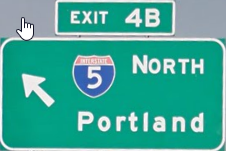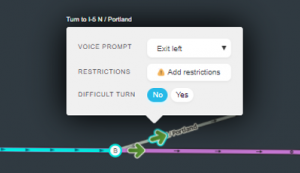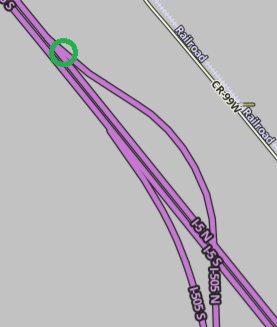WME proporciona la capacidad de anular las instrucciones de giro proporcionadas durante la navegación para que los editores puedan personalizar esas instrucciones para que coincidan mejor con la realidad de la carretera.
Use una anulación de instrucción de giro (TIO) siempre que la instrucción predeterminada Waze seleccionada no sea la instrucción deseada para el conductor. El TIO reemplaza por completo la instrucción predeterminada Waze seleccionada , incluido el TTS y la lista de instrucciones.
| No se preocupe por reemplazar los diseños de intersección existentes que actualmente producen la instrucción deseada (como micro-doglegs y un segmento de código auxiliar virtual ). Estas intersecciones se pueden actualizar a medida que se requieran otros cambios en esa intersección en el futuro. |
Principios
El TIO se desarrolló para situaciones poco comunes en las que las instrucciones predeterminadas de Waze podrían confundir al Wazer promedio. Sin embargo, no pretendía ser un medio para forzar un estilo de instrucción alternativo a gran escala cuando los Wazers típicos ya están acostumbrados y razonablemente cómodos con el estilo predeterminado. Además, tenga en cuenta que es más lento analizar y verificar las uniones que usan TIO. La gran mayoría de los cruces deberían usar las instrucciones predeterminadas de Waze.
Cuándo guardar las instrucciones predeterminadas de Waze
Nunca fuerce una instrucción hasta que haya considerado el contexto, las compensaciones y las alternativas. Los ejemplos de cuándo no anular las instrucciones predeterminadas de Waze incluyen:
- Mejora insignificante. La consistencia de las instrucciones es importante tanto para los conductores como para los editores que diagnostican problemas de navegación. Por lo tanto, no agregue un TIO simplemente por razones estilísticas donde no reduce significativamente la confusión del conductor sobre la instrucción predeterminada.
- Correcciones simples en la geometría del segmento lograrán la instrucción deseada. Si una geometría incorrecta en una intersección está causando una instrucción no deseada, y un cambio en la geometría que refleja con mayor precisión el camino que toman los conductores a través de la intersección dará la instrucción deseada, simplemente corrija la geometría. Esto es mucho mejor que agregar una anulación sobre una geometría incorrecta. Tenga en cuenta los ángulos construidos deliberadamente para fines especiales y asegúrese de preservar la funcionalidad para la que fueron diseñados.
- Anular es lo mismo que Waze seleccionado. No fuerce una anulación que coincida con el valor predeterminado de Waze. No logra nada excepto hacer que el mapa sea más difícil de mantener.
- Maniobras obvias. Si Waze por defecto no proporcionaría instrucciones para una maniobra obvia, no fuerce una. Las maniobras obvias generalmente implican buena visibilidad, geometría intuitiva o convencional, señalización clara y consistente, o una notable falta de alternativas.
- Cambios que no afectan al conductor. No fuerce una instrucción simplemente para confirmar los cambios en el nombre, estado, vecindario o dirección cardinal de una carretera. Esto se duplica cuando dichos cambios no están firmados y la información no puede ser de utilidad para el controlador. Además, la aplicación Waze muestra de manera destacada los nombres de las carreteras a lo largo de la ruta, por lo que dicha información ya estará disponible para el conductor sin forzar una instrucción.
Continuar
Los principios de uso del Continuar TIO son más complejos que los de otras anulaciones. A diferencia de otras instrucciones de Waze, la instrucción "Continuar" es informativa, no instructiva ; no le dice al conductor que ajuste el rumbo. Sin embargo, Waze emitirá la instrucción "Continuar" como lo haría con cualquier otra, ofreciendo múltiples advertencias anticipadas y una alerta final en el lugar de la anulación.
Como resultado, el Continue TIO es una espada de dos filos. Por un lado, es una forma ideal de notificar al conductor sobre cambios importantes en las circunstancias de la carretera. Por otro lado, el conductor puede recibir avisos repetidos esencialmente para no hacer nada. Antes de agregar un Continuar TIO uno, por lo tanto, debe evaluar varias compensaciones.
Beneficios
- Manejo de sorpresas. Alertar al conductor sobre un cambio potencialmente sorprendente en el carácter de la carretera (por ejemplo, de una calle de superficie a una rampa de entrada a la autopista) o sobre un cambio inesperado y posiblemente problemático en el estado legal / financiero de la carretera;
- Contraintuitivo continúa. Confirmando que uno debe continuar por delante, incluso si hacerlo parece entrar en conflicto con las señales de la carretera, el tráfico o la señalización;
- Transiciones de larga distancia. Asesoramiento sobre las transiciones a las carreteras principales en las que el conductor puede estar a grandes distancias (particularmente cuando hace la transición "hacia arriba" a dichas carreteras desde rutas menos significativas) para establecer el contexto para una instrucción posterior que puede estar a horas de distancia; y
- Notificación de renumeración de salida (controvertido). Marcar un cambio en la numeración de salida de la autopista. Pocos editores consideran que este beneficio en sí mismo vale los inconvenientes de forzar una instrucción Continuar.
Inconvenientes
- Instrucción de bloqueo. Suprimir una instrucción de navegación "real" que viene después de Continuar, para que el conductor no reciba ninguna advertencia de una maniobra requerida hasta que pase la Continuación;
- Instrucción latigazo cervical. Cuando las instrucciones bloqueadas tienen lugar inmediatamente después de Continuar, el controlador puede quedarse sin tiempo suficiente para ejecutar la instrucción bloqueada una vez que se emite. El Continuar puede incluso contradecir la señalización de la instrucción bloqueada y configurar al conductor para que falle, por ejemplo, al instruir al Continuar incluso cuando el conductor pasa los letreros que le indican una salida requerida;
- Redundancia / confusión. Confundir a los conductores al emitir lo que puede parecer una instrucción de manejo innecesaria cuando la mejor continuación parece obvia, especialmente si ningún otro curso es posible; y
- Repetición / distracción. Distraer a los conductores con varias repeticiones de una instrucción de baja prioridad, redundante o inaceptable cuando prefieren atender otras cosas.
La lista de casos de uso Continuar más adelante en este artículo intenta equilibrar estas compensaciones. Estas compensaciones pueden equilibrarse de manera diferente de una región a otra, por lo tanto, consulte la página de su estado para obtener pautas adicionales o comuníquese con su gerente estatal o coordinador regional . En caso de duda, no agregue un TIO Continuar.
How to use
Creation
| Before you set a Turn Instruction Override, It is highly recommended that you consult with a State Manager or other senior editor. |

When in WME and you click on a segment and hover over a green or yellow turn connection/restriction arrow, a grey box will appear with the Voice Prompt (Turn instruction Override (TIO)), the Time-based Turn Restriction (TBTR), and Difficult turn selections. If the turn is red (restricted), then the grey box will not appear.
Click on the Voice Prompt dropdown box to select an override.
Available options
When you click on the Voice Prompt dropdown menu, you have the following choices:

| Setting | Instruction Given |
|---|---|
| Waze Selected (default) | (this gives the default voice prompt) |
| None | No instruction is given |
| Turn left | The instruction "turn left" is given |
| Turn right | The instruction "turn right" is given |
| Keep left | The instruction "keep left" is given |
| Keep right | The instruction "keep right" is given |
| Continue | The instruction "continue straight" is given |
| Exit left | The instruction "exit left" is given |
| Exit right | The instruction "exit right" is given |
| U-turn | The instruction "make a U-turn" is given |
When something other than "Waze Selected" is the selected option, the Instruction override will appear in the Voice Prompt display when you hover over a green or yellow turn arrow.
Identifying on the map
- The default way to determine that a turn has an override set is to hover over the turn arrow.
- WME Toolbox helps to make identifying turns with override instructions set.
Removal
To remove a TIO, simply set the option back to Waze Selected.
Example use cases
U-turn
This works well for one way segments that have a u-turn only lane. You can post a "u-turn" verbal prompt on the first left turn and "None" on the second one.
Turn
Streets meeting at less than 46 degrees

If drivers reaching a junction tend to slow and/or stop at an angle less than 46° to the crossroad, but a turn left or right instruction is still warranted, a TIO may be used to force a turn instruction. Angles greater than 46° will issue turn instructions automatically and should not be overridden.
Before Waze introduced override capability, editors forced turn instructions at such intersections by adding "dogleg" geometry nodes to ensure junction angles between 46° and 170° exclusive. When concerned about the display, editors added doglegs at such fine scale as to be nearly invisible; these are called "micro-doglegs". Doglegs and micro-doglegs continue to work properly and there is no present need to replace them with overrides.
Note that doglegs remain a correct and useful technique. They are completely appropriate when they reflect the typical path of drivers as they slow and stop for a turn. Even if drivers tend to approach at very sharp angles, doglegs may be used to widen the junction angle to at least 20° whether or not a TIO is used. This makes it easier for drivers to identify the turn for closure via the app, as well as for editors to select the segment when using limited mobile tools (typically to drop or raise locks by request).
Other pre-override instruction-forcing methods, especially short "segment to nowhere" stubs and deliberately incorrect alternate names, are no longer appropriate. They continue to work, however, and should be updated with care.
Ambiguous turns
By default, Waze offers no instruction when two streets meet at their terminus and each can only turn into the other. In most cases the necessary maneuver is obvious and no instruction is required. However, if the turn is sharp and visibility is poor (e.g. due to steep grades, walls, buildings, or foliage) or the junction also involves an unmapped private, service or parking-lot road significant enough that the average driver could consider it a potential route, force a turn instruction to confirm the correct route.
At-grade connector

Depending on the length and angle of an at-grade connector, it may make sense for Waze to instruct "keep right/left" or "turn right/left". Use a TIO to ensure the most appropriate instruction is given to the driver. An example of an at-grade connector using an instruction override is shown here:
Exit/keep
Exit left


When there is a Big Green Sign (BGS) indicating an exit left, then add the Exit Left TIO. Some exit left signage might be yellow.
Discuss with your Regional Coordinator(s) and/or State Manager(s) to see if they want it added to locations where an HOV or HOT/Express Lane is separated from the regular freeway, highway, etc.
Wayfinder

A simple wayfinder is a turn instruction override where an instruction would not normally be voiced. This is most often a "stay to the right" or "stay to the left." A basic example is a roadway with a split where left lanes turn left and right lanes go straight ahead.
To ensure the driver is kept on the correct side of the roadway to stay on the expected route, we create an instruction override to ensure the driver is given enough advance notice to make sure they are on the correct side.
The image here is a composite showing both turns with the override set and which instructions have been applied in this specific case. To drivers continuing straight, the app will give the instruction "stay to the right to El Cajon Blvd." To drivers getting into the on-ramp, the app will say, "keep left to I-8 W."
A complex wayfinder is one where the s-out stubs are named differently than the subsequent segments. The stubs are named for the Big Green Sign (BGS) verbiage for clarity. Before overrides, complex wayfinders used unnatural road types to force instructions, but now these wayfinders should use correct road types and alternate names on the stubs where name continuity is to be preserved, along with TIOs to force instructions. See Wayfinder for further details.
Unusual on-ramp
A default surface-road-to-on-ramp "exit" instruction may be overridden with a "keep" in rare cases when either of the following conditions exist:
- The originating highway's continuation path is unclear (such situations often require wayfinders as well).
- The on-ramp's initial departure continues to share direction and pavement with the originating highway, either for an unexpectedly long distance or leading to two or more subsequent distributor on-ramps that are better instructed as exits than the initial departure. The latter application avoids issuing multiple "exit" instructions for what is effectively the same on-ramp.
Aside from the above situations, do not override the default "exit" instruction for shallow-angled on-ramp departures. While not immediately intuitive for new Wazers, "exit" is nevertheless Waze's current default for these situations. Overriding this default on a large scale could lead to problems. Meanwhile, our only alternative, the "keep" instruction ("stay" in some voices), is not always significantly clearer.
Continue
Unannounced roads with legal or financial implications
Restricted areas (border control point, military base)
When the best continuation is to a restricted area, add a Continue TIO, paired with a named stub segment if necessary, to let users know they will now be entering a restricted area.
Toll
When the best continuation is tolled, marked or unmarked (toll roads, bridges, paid entrances into large areas, etc.), add a Continue TIO, paired with a named stub segment if necessary. For barrier-toll systems, add the TIO only at the beginning of the toll area. Do not force a Continue at intermediate toll barriers.
Setting context in the instruction list
Without a Continue TIO, the next instruction could be from an entirely different road or freeway. Adding a Continue TIO would help set the context as to where the instructions are and increase the Wazer's confidence in the instructions given (or not given).
Terminus of a freeway
Where a freeway ends with a best continuation onto another freeway, add a Continue TIO to indicate the name of the continuing road.
When possible, do this at a point where the user can use this TIO to make a mental confirmation.
If the continuing freeway is signed before the terminus, place the TIO at the last exit, similar to how a wayfinder is set up today.
If it isn't signed, place the TIO where the freeway merges into the next freeway.
Consult with your state manager if the freeway status changes frequently or gradually, or if the freeway itself is insignificant. There could be multiple options as to what would be the best spot for a TIO, or if one is needed at all.
 |
On-ramp to a freeway

When the best continuation from a road (including off-ramps, parking lot roads, and rest areas) is an on-ramp to a freeway or expressway, add a continue TIO.
Continuing from an off-ramp
Use a Continue TIO when the name of the best continuation at the end of a ramp is not immediately obvious. Here are two scenarios that it's not immediately obvious:
Supplement a wayfinder
Because controlling the turn angles in Waze will never produce a continue instruction, a Continue TIO must be set in places where a wayfinder is warranted for a particular direction, but "keep" or "exit" would be misleading.
Add a continue TIO when:
- All travel lanes are correct—telling a user to "keep" or "exit" would mean an unnecessary lane change to that side of the road out of caution; or,
- Only the center lanes are correct in a 3-way fork.
Best continuation is not the obvious continuation
Many times, when there are many turn lanes, many vehicles turning, and a plethora of signage, and straight ahead doesn't look like the right way to go, the Wazer may be hesitant that Waze is not issuing an instruction. Add a continue TIO to help assure the Wazer that continuing straight is the correct way.
Use selectively, and consult your fellow area managers for consensus.
